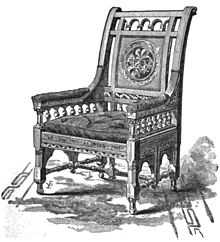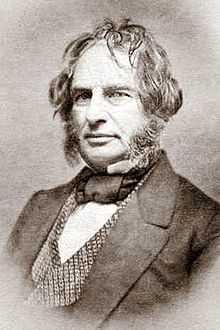The Village Blacksmith
.jpg)
"The Village Blacksmith" is a poem by Henry Wadsworth Longfellow, first published in 1840. The poem describes a local blacksmith and his daily life. The blacksmith serves as a role model who balances his job with the role he plays with his family and community. Years after its publication, a tree mentioned in the poem was cut down and part of it was made into an armchair which was then presented to Longfellow by local schoolchildren.
Synopsis
The poem is about a local blacksmith. Noted as being strong, he works by the sweat of his brow and does not owe anyone anything. Children coming home from school stop to stare at him as he works, impressed by the roaring bellows and burning sparks. On Sundays, the blacksmith, a single father after the death of his wife, takes his children to church, where his daughter sings in the choir. He goes through his life following the daily tasks assigned to him and has earned his sleep at night.
Origins
Longfellow said the poem was a tribute to his ancestor Stephen Longfellow, who had been a blacksmith, a schoolmaster, then a town clerk.[1] In 1745, this ancestor was the first Longfellow to make his way to Portland, Maine, the town where the poet would be born.[2] Longfellow wrote to his father on October 25, 1840: "There will be a kind of Ballad on a Blacksmith in the next Knickerbocker, which you may consider, if you please, as a song in praise of your ancestors at Newbury."[3]
The actual village blacksmith in the poem, however, was a Cambridge resident named Dexter Pratt, a neighbor of Longfellow's. Pratt's house is still standing at 54 Brattle Street in Cambridge.[4] Several other blacksmiths have been posited as inspirations for the character in the poem, including "The Learned Blacksmith" Elihu Burritt, who Longfellow once offered a scholarship to attend Harvard College.[5]
Publication and response

"The Village Blacksmith" was first published in the November 1840 issue of The Knickerbocker.[6] It was soon after printed as part of Longfellow's poetry collection Ballads and Other Poems in 1841.[7] The collection, which also included "The Wreck of the Hesperus", was instantly popular.[8] In 1879, years after the publication of "The Village Blacksmith", the local schoolchildren in Cambridge, Massachusetts presented Longfellow with an armchair made from "the spreading chestnut tree" in the poem which was recently cut down.[9] Under the cushion of the chair is a brass plate on which is inscribed, in part: "This chair made from the wood of the spreading chestnut-tree is presented as an expression of his grateful regard and veneration by the children of Cambridge".[10] From then on, Longfellow made it a rule to allow schoolchildren to be admitted into his study to see the chair.[11] He also composed a poem to commemorate his gift called "From my Arm-Chair". The site on Brattle Street in Cambridge where the tree once stood is now designated with a stone marker.[12]
Analysis
The title character of "The Village Blacksmith" is presented as an "everyman" and a role model: he balances his commitments to work, the community, and his family.[13] The character is presented as an iconic tradesman who is embedded in the history of the town and its defining institutions because he is a longtime resident with deeply rooted strength, as symbolized by the "spreading chestnut tree".[14] Longfellow uses the poem to glorify and celebrate a humble, plain person, much as John Greenleaf Whittier does in his poem "The Barefoot Boy".[15] Further, Simon Bronner notes that, like Nathaniel Hawthorne's woodcarver character in "Drowne's Wooden Image", Longfellow is praising the craftsman in a time of industrialization.[16]
Adaptations and influences
The poem, along with several others by Longfellow, was translated into Spanish by Colombian poet Rafael Pombo.[17] In several interviews, baseball player and manager Billy Southworth noted that his father recited the poem to him as a child, that he himself memorized it, and that it inspired him as an adult.[18]
In 1926, a comical song called "The Village Blacksmith Owns the Village Now" was published with words by Leslie Moore and music by Johnny Tucker.[19] The lyrics detailed how the blacksmith grew rich with the rise of the automobile by converting his shop into a service station. The song was recorded by popular U.S. comedians and bandleaders of the era including the Happiness Boys and Harry Reser.
In 1938, songwriters Tommie Connor, Jimmy Kennedy, and Hamilton Kennedy created a comical song and dance routine inspired by the poem; Glenn Miller's recording of the song was featured in the 1990 film Memphis Belle.[20]
References
- ↑ Nelson, Randy F. The Almanac of American Letters. Los Altos, California: William Kaufmann, Inc., 1981: 226. ISBN 0-86576-008-X
- ↑ Hawthorne, Hildegarde. The Poet of Craigie House: The Story of Henry Wadsworth Longfellow. New York: D. Appleton-Century Company, 1936: 130.
- ↑ Hilen, Andrew (editor). The Letters of Henry Wadsworth Longfellow. Cambridge, MA: Harvard University Press, 1967: vol. II, p. 259. ISBN 0674527259
- ↑ Wilson, Susan. Literary Trail of Greater Boston. Boston: Houghton Mifflin Company, 2000: 105. ISBN 0-618-05013-2
- ↑ Della Valle, Paul. Massachusetts Trobulemakers: Rebels, Reformers, and Radicals from the Bay State. Guilford, CT: Globe Pequot Press, 2009: 140. ISBN 978-0-7627-4850-1
- ↑ Gale, Robert L. A Henry Wadsworth Longfellow Companion. Westport, CT: Greenwood Press, 2003: 278. ISBN 0-313-32350-X
- ↑ Williams, Cecil B. Henry Wadsworth Longfellow. New York: Twayne Publishers, Inc., 1964: 78.
- ↑ Calhoun, Charles C. Longfellow: A Rediscovered Life. Boston: Beacon Press, 2004: 138. ISBN 0-8070-7026-2.
- ↑ Williams, Cecil B. Henry Wadsworth Longfellow. New York: Twayne Publishers, Inc., 1964: 100.
- ↑ Harberts, Ethel F. Footprints of Henry W. Longfellow: A Travel Guide to America's Favorite Poet. St. Cloud, Minnesota: North Star Press, 1993: 78. ISBN 0-9635735-0-0
- ↑ Sullivan, Wilson. New England Men of Letters. New York: The Macmillan Company, 1972: 198. ISBN 0-02-788680-8.
- ↑ Wagenknecht, Edward. Henry Wadsworth Longfellow: Portrait of an American Humanist. New York: Oxford University Press, 1966: 109.
- ↑ Schwehn, Mark R. and Dorothy C. Bass. Leading Lives That Matter: What We Should Do and Who We Should Be. Grand Rapids, Michigan: William B. Eerdmans Publishing, 2000: 281. ISBN 0-8028-3256-3.
- ↑ Laurie, Bruce. Beyond Garrison: Antislavery and Social Reform. New York: Cambridge University Press, 2005: 175. ISBN 0-521-60517-2
- ↑ Curti, Merle. The Growth of the American Thought (sixth edition). Transaction Publishers, 2004: 296. ISBN 0-87855-879-9
- ↑ Bronner, Simon J. Explaining Traditions: Folk Behavior in Modern Culture. University of Kentucky Press, 2011: 138–139. ISBN 978-0-8131-3406-2
- ↑ Jaksić, Iván. The Hispanic World and American Intellectual Life, 1820-1880;;. Palgrave Macmillian, 2012: 107. ISBN 9781137014917
- ↑ Skipper, John C. Billy Southworth: A Biography of the Hall of Fame Manager and Ballplayer. Jefferson, NC: McFarland & Company, 2013: 90. ISBN 978-0-7864-6847-8
- ↑
- ↑ Kennedy, J. J. The Man Who Wrote the Teddy Bears' Picnic. AuthorHouse, 2011: 134–137. ISBN 978-1-4567-7811-8
External links
| Wikisource has original text related to this article: |
- 1890 illustrated version at Google Book Search
- "The Village Blacksmith" at Cambridge Historical Society
| |||||||||||||||||
